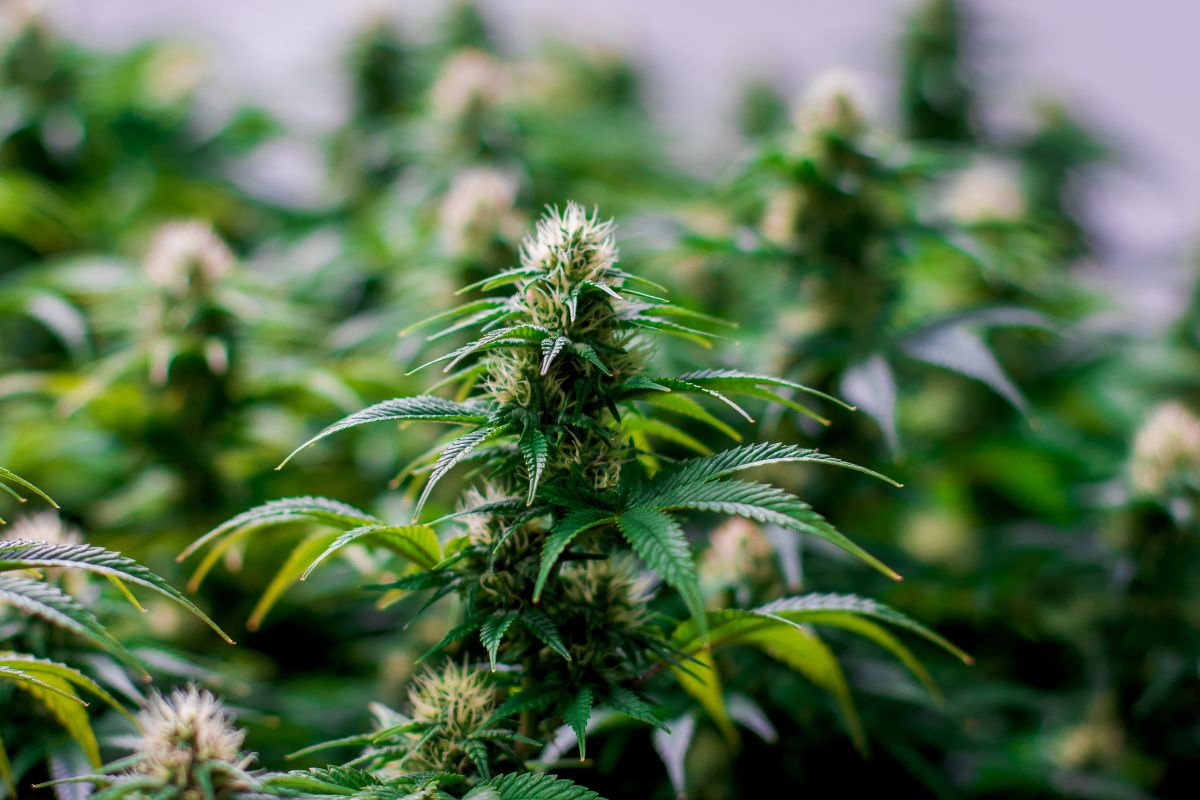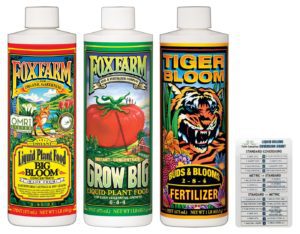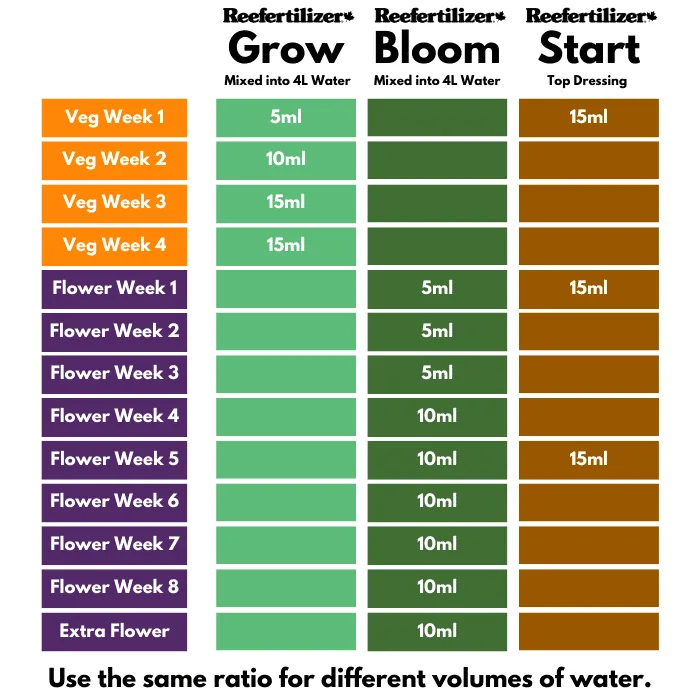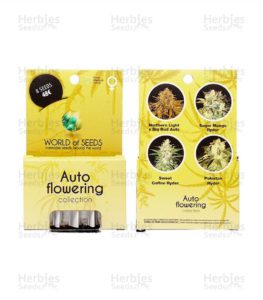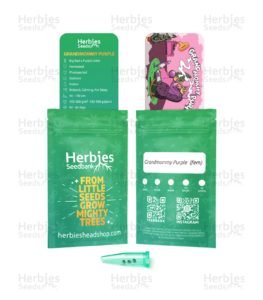There’s a lot to know when it comes to cannabis nutrition. Before we get into the deep dive, here are three simple rules for novice growers:
- Buy a nutrient kit for your specific grow setup (indoor/outdoor; dirt/hydro)
- Read the included feed chart
- Follow the feed chart
We will explain more about the nutrients needed during different cannabis growth cycles so you can create your own ideal cannabis feeding schedule. That said if you find yourself getting lost in all the information, remember that nutrient producers create feed charts to help you.
Understanding Nutrients
All plants need to undergo photosynthesis in order to thrive. Photosynthesis requires three main things: light, water, and nutrients. Normally, these nutrients come from the soil. Here’s a breakdown of cannabis nutrients and what they do.
NPK: the Primary Macro Nutrients
These chemicals are the main nutrients all plants need to photosynthesize.
- Nitrogen (N) – a mobile nutrient all plants use to make protein
- Phosphorus (P) – helps plants create energy by breaking down scratches and sugars. A major player in flower production
- Potassium (K) – helps plants form roots and stalks, also helps make proteins and enzymes.
Together, these form the NPK ratio. Those are the three numbers you’ll see printed on almost every bottle of cannabis nutrients. A cannabis plant needs different amounts of each chemical at different phases. For example, it needs a lot of phosphorus in the flowering stage, but in the vegetative stage, it needs more nitrogen.
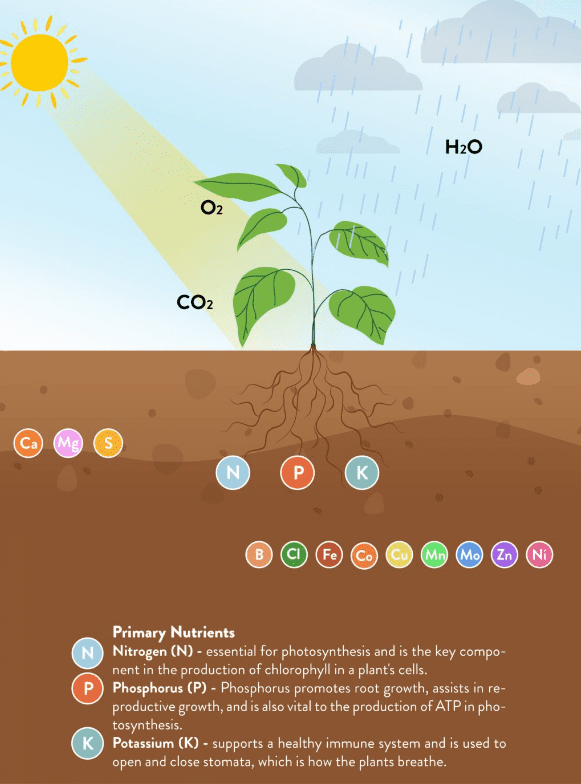
Secondary Macronutrients
Beyond NPK, you will also need additional nutrients to help your plants grow. They are:
- Calcium (Ca) – gives the plant structure and rigidity
- Magnesium (Mg) – A key component of chlorophyll that plants need to photosynthesize
- Sulfur (S) – helps make amino acids, proteins, oils, and chlorophyll
Micronutrients
Last but not least, there are micronutrients necessary for good plant health. These other nutrients are only in tiny amounts so it’s very easy to overdo it on these:
- Iron (Fe) – helps convert light to sugar and gives the plant cells pigment
- Zinc (Z) – helps to make Plant Growth Hormone
- Manganese (Mn) – helps make pollen structures and utilizes Nitrogen
- Boron (B) – reinforces plant cell wall structure
- Copper (Cu) – helps with photosynthesis and metabolizing sugars
- Molybdenum (Mo) – helps enzymes produce necessary chemical reactions
- Silicon (Si) – Helps strengthen plant cell walls
Now if you really love the idea of playing around with different nutrients, you might find a hydroponic growing more to your liking. You will see the effects more immediately, and it’s easier to correct overfeeding. That said, high-quality soil is often easier to use.
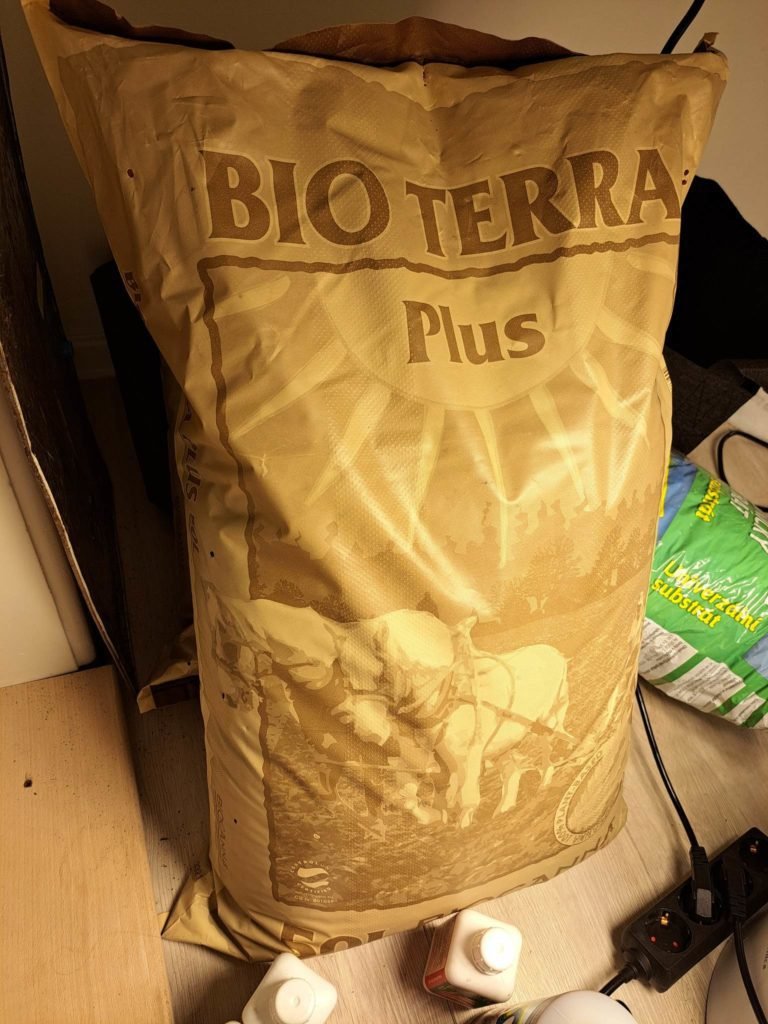
Nutrient Lockout and Nutrient Burn in Cannabis Plants
If there is any lesson to be learned from growing cannabis, it’s that you can give too much! There are a couple of bad things that can happen when you overfeed your cannabis plants.
Nutrient lockout is when your cannabis plants can’t absorb the nutrients they need to survive. It typically happens when there’s too high a concentration of nutrient salts in the solution or soil. At this point, adding nutrients will only worsen the problem. It can also occur if your soil has a poor pH. Signs of nutrient lockout include:
- Stunted growth
- Limp and yellow foliage
- Possible leaf burn
Nutrient burn isn’t as bad as lockout, but it can still stunt your plant’s growth. It’s basically your plant’s version of getting fat. Instead of placing the excess nutrients as fat around the body, it pushes it as far out to its leaves as possible. Here’s what to watch out for:
- Leaves start with overly deep green coloration
- Leaves tips begin to turn downward
- The very tips of the leaves appear burned
- As nutrient burn progresses, leaves start yellowing and browning
- Leaves curl and twist inward
If you suspect either nutrient lockout or burn is occurring, you’ll want to flush your plants with pH balanced distilled water. For hydro growers, this means running fresh water through the reservoirs for 24 hours, soil growers will need to fill and drain pots multiple times.
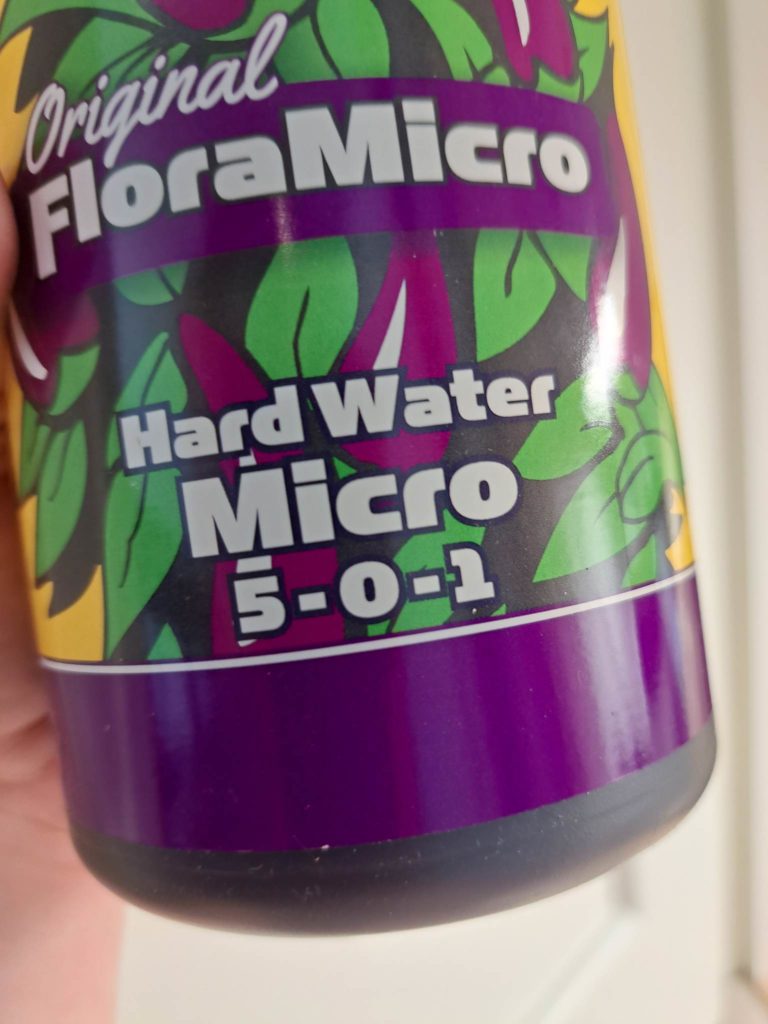
One of the reasons growers opt for organic nutrients is they can help you avoid nutrient burn. They are slow release nutrients, so they take longer for the cannabis plant to absorb, and therefore are easier for the plant to keep in balance.
If you’re using synthetics, realize they are more powerful. It’s best to be conservative when mixing your nutrient solution. It’s way easier to give a deficient plant more nutrients than it is to take them out.
Cannabis Fertilizer Purchasing Basics
There are a million brands of cannabis nutrients out there. For the most part, as long as it fits your growing medium and preferences, they’re all pretty good. Here are the main points to consider when purchasing.
- NPK Ratio: brands will use similar but distinct nutrient ratios they consider favorable
- Synthetic vs. Organic Ingredients: many growers swear by organics, others prefer the more powerful synthetic nutrients.
- Soil vs Hydro: organic matter placed in a hydro setup can cause harmful bacterial growth, and hydro nutrients put in the soil might not be concentrated enough to feed your plants. Some brands claim they can be applied to both, but it’s best to stick with nutrients meant for your growth medium.
- Supplements: these have low NPK ratios so help alternate aspects of growth.
Pro tip: It’s really easy for newbie growers to overdo it on supplements. Pick one or two to either make up for a soil deficiency or really lean into a particular strain’s characteristics. Nutrient deficiency is a lot easier to correct than nutrient burn.
Pro tip #2: Do NOT use Miracle-Gro! Miracle-Gro and other lawn fertilizers have extended-release nutrients that keep putting nitrogen in the soil for up to six months. This means you can seriously burn your plants during the flowering stage
Synthetic Vs Organic Nutrients
It’s the great debate. Synthetic fertilizers have a greater nutrient concentration and can make up for poor soil quality. Hydroponic growers are leery about using organic components because even if they claim to be hydro-friendly, organic matter in a hydroponic nutrient solution can cause harmful things to grow in the reservoir.
That said, some people swear that marijuana plants grown in organic soil taste better. It’s also better if you’re trying to improve the long-term soil quality of your garden. Also if you are a neurotic overfeeder, organic nutrients are less likely to be harmful to plant health.
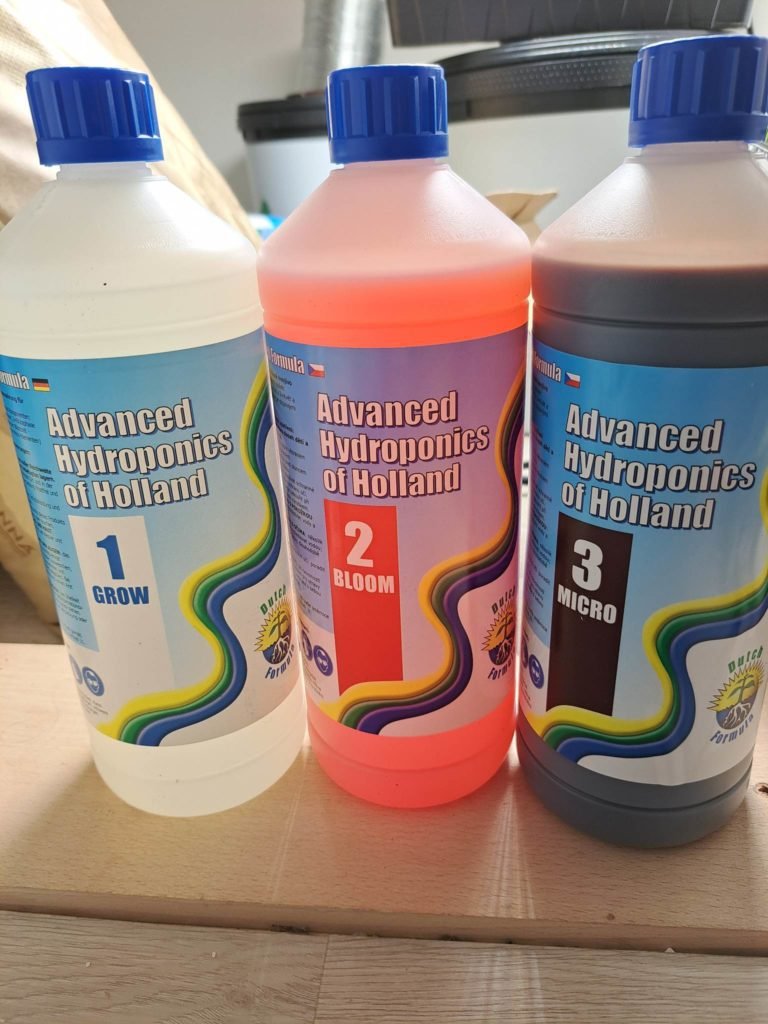
Cannabis Feeding Schedule Basics
Before we get into this, it’s important to remember that both under and overfeeding your plants will negatively affect your yield. Underfeeding is easier to correct than overfeeding.
As far as how often you should feed your plants, that depends on what medium you are growing in.
- Hydroponics – add nutrients every time you add water
- Fertilized soil – add nutrients every 1-2 weeks
- Poor soil – add a nutrient solution every week
When you are growing in soil, you’ll want to only water it every 2-3 days to let the soil dry out a bit. Cold, damp soil can be a breeding ground for harmful bacteria and affect your plant’s ability to respirate.
Now, the feeding schedule differs from setup to set up. This is why you want to buy a kit tailored to your growing needs, and follow the feeding chart. For example, here’s the Reefertilzer multi-step feeding schedule. This product is for soil-grown cannabis and comes in a powder that you mix into your watering can.
Now, this feeding schedule has a major flaw: it does not include the flush period. Flushing is important because the nutrients that feed your plants taste funky when you smoke them. When growing in soil, you need to give your plants pure water for the last 2 weeks before you harvest them. Hydroponic cannabis plants only need a week to flush.
Here’s an example of a feeding chart for a hydroponic system. It’s General Hydroponic’s multi-step feeding schedule:
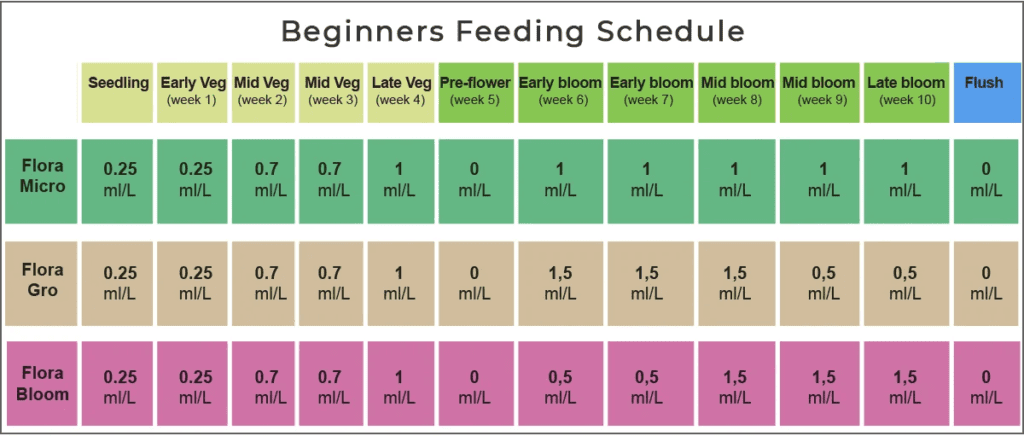
General Hydroponics is a great reference source because they have an entire section of its website devoted to feedcharts.
How Do I Know My Cannabis Plant Has Enough Nutrients?
First, you want to check the pH of the soil. If it’s not right, it doesn’t matter what you feed your plant, it won’t be able to absorb it. The ideal pH is 6.3, but anything between 5.8 and 6.8 is fine. Also, check the pH of the water you’re using, it can vary at different times of the year.
In order to diagnose potential nutrient issues, you are going to want to closely observe your plant. Here’s a quick handy chart from Dutch Passion:
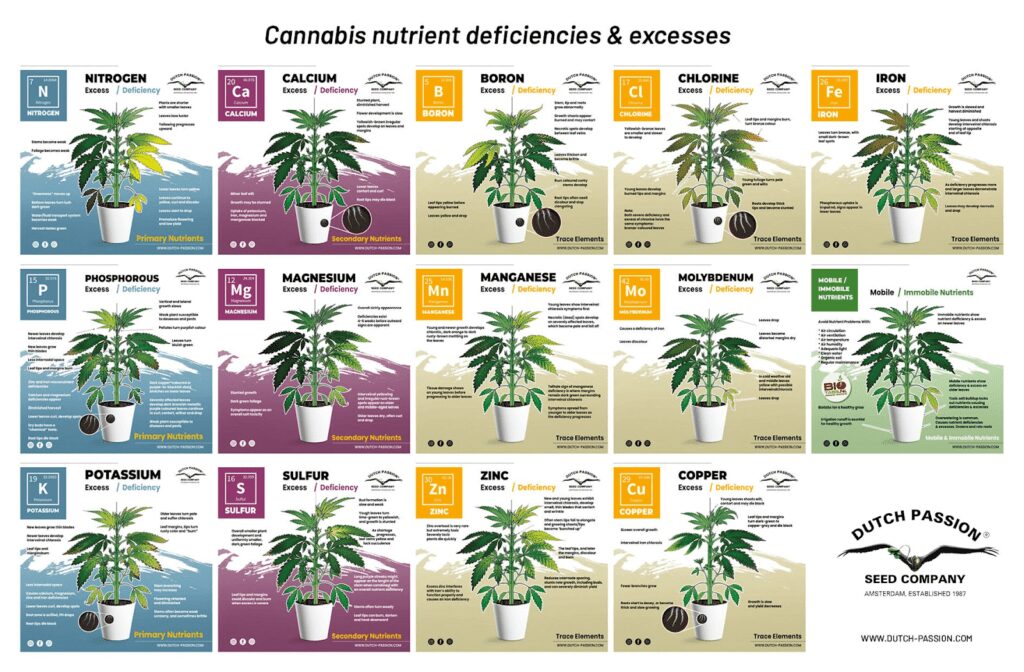
We recommend Dutch Passion’s visual guide to nutrient deficiencies for more details and visual examples of each excess and deficiency.
When to Start Giving Seedlings Nutrients
In the seedling stage, the cannabis plant gets all their nutrients from the seed and soil around it. Don’t feed a germinating seed. For the most part, young plants don’t need extra nutrients. In fact, doing so could cause it to burn which could kill it at this early growth stage,
Hydroponic nutrients often have a very diluted seedling solution to not burn. Most growers start feeding at 3-4 weeks old, when it has 3-4 true leaves. This is technically early vegetation, and will be referred to as such later on.
Nutrients Needs During the Vegetative Stage
The vegetative phase is when growing cannabis puts down roots and develops the majority of its foliage. It does not produce flowers during this time. This part if the life cycle has the biggest variance, it can last between 3 and 16 weeks. Outdoor growers cannot control how long this phase lasts. Indoor growers can initiate flowering by giving the cannabis plants less than 12 hours of light.
In the early veg phase, some growers opt for a light solution like 2-1-2, while others go for a stronger 4-2-3 nutrient mix. If you are shortening the vegetative phase, go for a slightly stronger solution.
Vegetating plants need a lot of nitrogen to support leafy growth. You’ll want to ramp up the nutrients during the middle of the vegetative stage. A nutrient mixture around the 10-5-7 range will help it put down roots and develop the branches it needs to support large buds. Skip this part in your customized feeding schedule if you intend to shorten the vegetative stage.
By the last week of the vegetative stage, you’ll want to take down the nitrogen to get it ready to produce flowers. The standard pre-bloom nutrient mix ratio is 7-7-7.
Pro tip: Outdoor growers should water further away from the plantation site to encourage the roots to stretch.
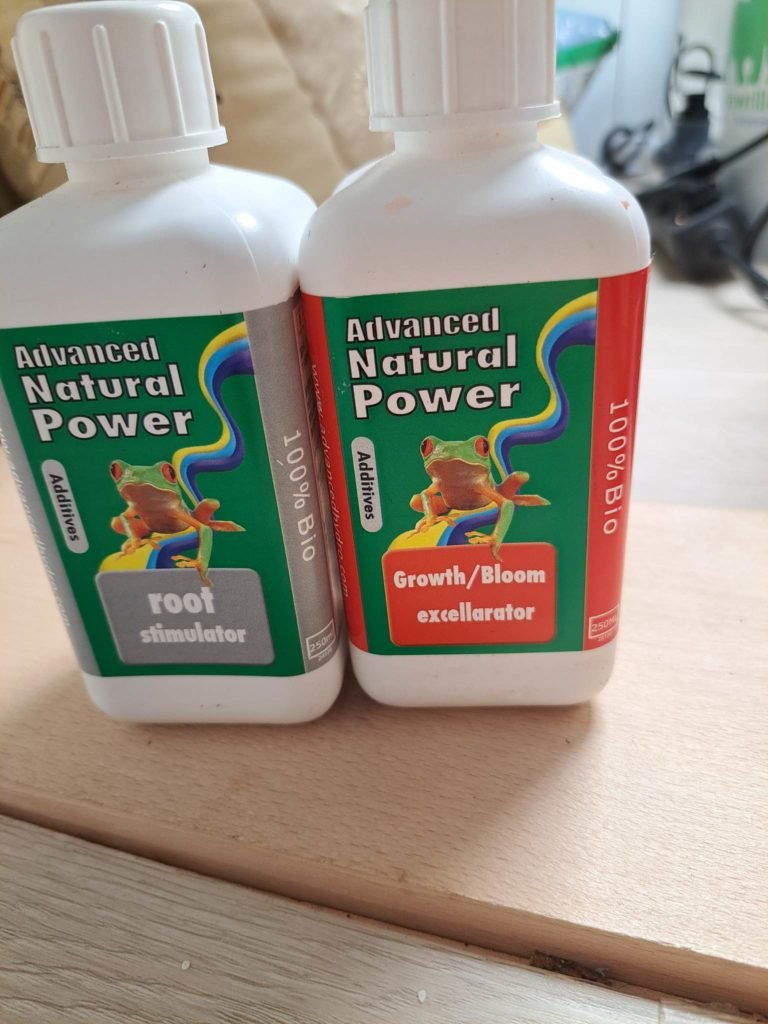
How Often To Feed Cannabis In the Flowering Stage
There are a lot of factors that go into how often your plants should be fed, but the general rule of thumb is 1-2 times a week. This applies to both vegetative and flowering plants. The thing that changes between these phases is what you feed them, not how often. Here it needs a lot more potassium for bud and resin production.
The flowering stage typically lasts 7-9 weeks. There are four parts of the flowering phases: early bloom, midbloom, late bloom, and flush.
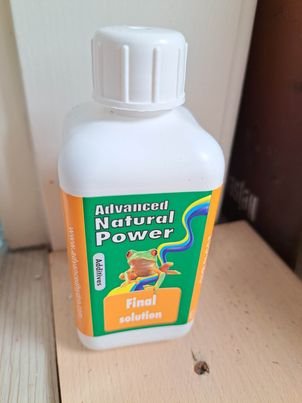
In the first few weeks of flowering, the plant can double in height. Give it a nutrient mix of around 5-7-10 to support this growth and get it ready to grow flowers.
Mid bloom hits around week 4-5 of flowering. Most marijuana plants stop growing taller by this time and put all their energy into making flowers. They need an NPK ratio of about 6-10-15 at this time.
Late bloom occurs around weeks 6-9, depending on how quickly your strain flowers. Around this time you taper your marijuana plants down to a 4-7-10. Before you harvest your plants, water them with nothing but fresh water to clear out the fertilizers.
Pro tip: even if your fertilizers claim to be “no flush,” always flush. Some sellers offer a flushing solution, but they aren’t necessary.
Factors Affecting Feeding Schedule
Here are things to consider when putting together your feeding schedule:
- Growing medium – In addition to hydroponics and soil, you can also grow cannabis in perlite, coco coir, expanded clay pellets, Rockwool, and vermiculite. These have different pHs and water retention, which in turn affects the feeding schedule.
- Indoor vs outdoor growing – this affects how much control you have over the growing process. With indoor plants, you decide when they begin vegetation and flowering. It is also easier to control pests in an indoor growing environment.
- Organic vs synthetic fertilizer – plants have an easier time absorbing synthetic fertilizers. Organic fertilizer is better for overfeeders.
- Photoperiod vs autoflower plants – this is probably the least important factor, but they do enter different growth stages at different times.
Creating a Feeding Schedule
Here’s how to make a customized feeding schedule.
- Step 1: Look up the strain you are growing to determine its growing phases. A photoperiod seed will enter different growth phases based on light exposure, an autoflower seed will have a genetically predetermined growth cycle.
- Step 2: Assess your grow medium and purchase an appropriate fertilizer. If you are using pre-fertilized soil, go easy on the feeding.
- Step 3: Look up the feeding chart on your nutrients and compare it to your plant’s growth cycle. You may also want to add one additional supplement to either make up for less-than-ideal soil or to lean into a strain’s particular feature. Do not overdo it on the supplements.
- Step 4: Pull out a chart or a calendar and plot out what you intend to give your plant week by week. If you are skipping straight to the flowering stage, you can skip the mid-veg nutrient solution.
Make sure to closely observe your plant. The ideal cannabis feeding schedule is one that responds to the plant as it’s growing.
NPK Feeding Recommendations for Different Growth Stages
Of course every plant is different, but here are some recommended NPK ratios for every stage of growth:
- Germination/seedling: no fertilizer (or special hydroponic solution)
- Early veg (3-4 weeks post-germination): 2-1-2 to 4-2-3
- Mid veg (5 weeks PG): 10-5-7
- Late veg (6 weeks PG): 7-7-7
- Early flowering (7-9 weeks PG): 5-7-10
- Midblom (10-12 week PG): 6-10-15
- Mid-Late Bloom (13 weeks PG): 4-7-10
- Final flush (14-16 weeks): no fertilizer
Bear in mind that the growth phases are based on an autoflower seed. Make sure to check your strain’s growth patterns and adjust accordingly.
Tips for Successful Feeding
- Buy a nutrient mix that is formulated for your growing medium
- Follow the instructions that come in your fertilizer
- Only try one supplement at a time
- Test your soil/water to make sure it’s the right pH
- Water ever 2-3 days, feed every 1-2 weeks
- Closely observe your plant for signs of burn or deficiency
- When in doubt, correct for lockout or burn first
Common Questions
You’ve got questions about cannabis nutrients, we have answers.
Should I use nutrients every time I water?
Only if you’re growing in hydroponics. If you’re using soil or a similar medium, water it every 2-3 days and feed it every 1-3 weeks.
Can I use regular plant fertilizer on cannabis?
Don’t use lawn fertilizers like Miracle-Grow on flowering plants like cannabis. If for whatever reason you can’t use cannabis nutrients, use either rose or tomato fertilizer. These are flowering plants with similar nutrient requirements.
Should I mix and match brands of cannabis nutrients?
It’s best practice to find a brand of cannabis nutrients you like and stick with it. These companies make products that are formulated to go together.
Final thoughts
There’s a lot to know about cannabis nutrients. If at any time you get lost or feel confused, read the instructions. It’s easy to lose the forest for the trees here. When in doubt, read the instructions that came on the bottle of nutrients.
More about cannabis
- How To Treat A Magnesium Deficiency In Cannabis
- It’s Not O-K: Potassium Deficiency in Cannabis
- How to harvest cannabis (and use the entire plant)
- Male Weed Plant Stages: Don’t Ruin Your Crop
- How To Decarb Weed For Homemade Cannabis Products
- Loving the Ladies: Female Weed Plant Stages
- Patience is a Virtue: Curing Buds for Best Taste
- Understanding weed light cycles: Get the most from your harvest
- When to switch to flower nutrients for high cannabis yield
- How to make live resin at home, step-by-step

